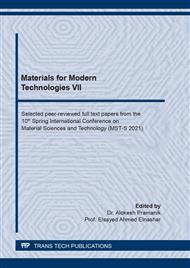[1]
K. Habib, Measurement of the electrical resistance of aluminum samples in sulphuric acid solutions by optical interferometer techniques, Int. J. Light Electron Opt. (OPTIK) 115 (4) (2004) 145–150.
DOI: 10.1016/s0030-4026(08)70001-9
Google Scholar
[2]
K.Habib, Measurement of Bulk Resistivity/Conductivity of Carbon Steel in Inhibited Seawater by Holographic Interferometry Techniques. J Electrochem Soc 158(12)(2011):C445-C449.
DOI: 10.1149/2.056112jes
Google Scholar
[3]
K.Habib, Measurement of surface resistivity and surface conductivity of anodised aluminium by optical interferometry techniques. Opt Laser Technol 44(2012):318-321.
DOI: 10.1016/j.optlastec.2011.07.006
Google Scholar
[4]
Z.Zhang, C.Cai, H.Cao, Z.Gao, J. Zhang , C.Cao, Evolution of the electrochemical characteristics during pitting corrosion of pure aluminum in sodium chloride solution. Acta Metall. Sinica (Engl. Lett.) 18(4)(2005):525–532.
Google Scholar
[5]
P.Potucek, R. Rateick, V. Birss, Impedance characterization of anodic barrier Al oxide film beneath porous oxide layer. J Electrochem Soc 153(8)(2006):B304–B310.
DOI: 10.1149/1.2208737
Google Scholar
[6]
J.Sarkar, G.Khan, and A. Basumallik, Nanowires: properties, applications and synthesis via porous anodic aluminum oxide template. Bull Mater Sci 30(3(2)(2007):271–290.
DOI: 10.1007/s12034-007-0047-0
Google Scholar
[7]
L.Li, C.Wang, S,Chen, A.Hou, X.Yang, Investigation of the pitting of aluminum induced by chloride ions by holographic microphotography. J Serb Chem Soc 73(5) (2008):561–568.
DOI: 10.2298/jsc0805561l
Google Scholar
[8]
J.Lu, and G.Zou,Application of speckle technique in corrosion process monitoring of an aluminum alloy. Proc SPIE 7522 (2010).
Google Scholar
[9]
B.Yuan, C.Wang, L.Li, S.Chen, Fast visualization of the mass transfer processes at the electrode/electrolyte interface with a Mach-Zehnder interferometer. Russ J Electrochem 48(8) (2012): 804-809.
DOI: 10.1134/s1023193512070129
Google Scholar
[10]
K.Habib, W. Mohammad, F. Karim, J. Dutta, Resistance Values of Aluminum Oxide Film in Situ during Anodization of Aluminum by Fabry-Pérot Interferometry. ECS Trans 80 (10) (2013): 1221-1229.
DOI: 10.1149/08010.1221ecst
Google Scholar
[11]
H.Uhlig, Corrosions Corrosion Control. Wiley, New York, NY(1971).
Google Scholar
[12]
K.Habib, D.L. capacitance-emission spectroscopy of determining the electrochemical behavior of anodized aluminium in aqueous solutions. Proc. SPIE 5826(2005).
Google Scholar
[13]
K.Habib, S.Habib, AC impedance-emission spectroscopy of determining the electrochemical behavior of anodized aluminum in aqueous solutions. Proc SPIE 4101(2006).
DOI: 10.1117/12.498387
Google Scholar
[14]
H.Shi Kuo, W.Ta Tsai, Electrochemical behavior of aluminum during chemical mechanical polishing in phosphoric acid base slurry. J Electrochem Soc 147 (1)(2000): 149-154.
DOI: 10.1149/1.1393168
Google Scholar
[15]
O.Jessensky, F. Muller, U. Gosele, Self-organized formation of hexagonal pore arrays in anodic alumina, Appl Phys Lett 72 (10)(1998):1173-1176.
DOI: 10.1063/1.121004
Google Scholar
[16]
J.Gonzaaˆ, V. LoaˆPez, A.Bautista, E. Ortero, X. NoaˆVoa, Characterization of porous aluminum oxide films from A.C. impedance measurements. Appl Electrochem 29(1999): 229-238.
Google Scholar
[17]
G.Hernandez, Fabry–Pe´rot Interferometers, Cambridge University Press, Cambridge, UK (1986).
Google Scholar
[18]
R.Baboian, Electrochemical technique for corrosion, Houston, National Association of Corrosion Engineering (NACE), Houston, TX(1977).
Google Scholar


